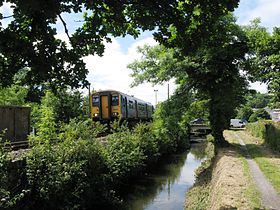Atlantic Coast Line, Cornwall
| Atlantic Coast Line | |
|---|---|

The line at St Blazey Bridge
alongside the remains of the Par Canal |
|
| Overview | |
| Type | Branch line |
| System | National Rail |
| Status | Open |
| Locale | Cornwall |
| Termini |
Par Newquay |
| Stations | 7 |
| Operation | |
| Opened | 1876 (passengers) |
| Owner | Network Rail |
| Operator(s) |
Great Western Railway CrossCountry (seasonal) DB Schenker (freight) |
| Depot(s) | St Blazey |
| Rolling stock |
Class 43 "HST" Class 150 "Sprinter" Class 153 "Super Sprinter" Class 220 "Voyager" Class 221 "Super Voyager" |
| Technical | |
| Line length | 20 3⁄4 miles (33 km) |
| Number of tracks | 1 |
| Track gauge | 4 ft 8 1⁄2 in (1,435 mm) standard gauge |
| Loading gauge | RA6 / W6A |
| Operating speed | 50 mph (80 km/h) |
The Atlantic Coast Line is a 20 3⁄4 miles (33 km) Network Rail branch line which includes a community railway service in Cornwall, England. The line runs from the English Channel at Par, to the Atlantic Ocean at Newquay.
The Atlantic Coast Line starts from Par station, in the village and port of Par. The station is on the Cornish Main Line, and trains to Newquay use a curve of almost 180 degrees before joining the route of the original Cornwall Minerals Railway near the former St Blazey station. The route of the CMR is followed for the rest of the journey.
Originally built as a standard-gauge tramway from the 1840s to serve Newquay Harbour, the line was upgraded for locomotives in 1874 and passenger services began between Newquay and Fowey on 20 June 1876. There was no connection at the present Par station until 1892 when the broad-gauge main line was 'narrowed' to standard gauge by the Great Western Railway and the connecting curve was built from St Blazey. From St Blazey, the CMR was built along the course of the even earlier Par Canal, originally built to serve the nearby Fowey Consols mine, as far as its terminus at Pontsmill, where the Luxulyan Valley is entered. The thickly wooded terrain and steep granite slopes of this valley surround the fast-flowing River Par, contain a large concentration of early 19th century industrial remains and have been designated a World Heritage Site.
...
Wikipedia
